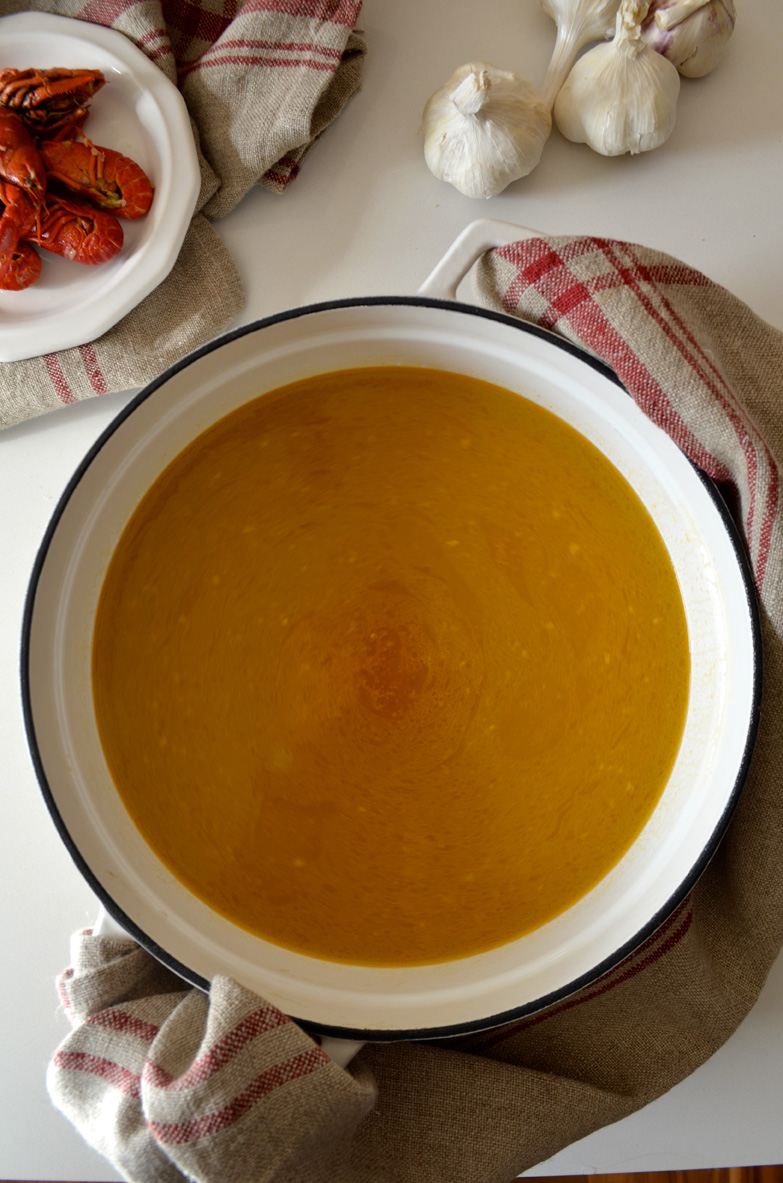Seafood Stock – Caldo de Pescado


I have to confess it has not been easy to develop a recipe for seafood stock that would resemble the ones you can make in Spain, and particularly in my region of Valencia. The availability of a wide variety of white fish and shellfish, that one can purchase not only at fishmongers but at the fish counter inside any supermarket, is without compare. Not only that, but in Spain fish and shellfish are sold “whole,” and by that I mean with their heads on.
I remember on one of my first days in Fort Wayne, going to the fish counter at my local supermarket, and seeing beautiful, clean fish filets, next to peeled off, deveined and beheaded prawns and shrimp, lying perfectly lined on a bed of ice chips. When I inquired about fish and shellfish “the way it comes out of the sea”, the fishmonger promised to ask his fish supplier for whole prawns (I was particularly interested in their heads!). He did, and was as surprised as I was to hear that even his supplier received the prawns already beheaded. Because a good, savory fish stock (one made with the bones and heads of white fish and the heads and peels of prawns, where most of the flavor is concentrated) is essential to make paella de mariscos, seafood paella, for years I didn’t even tackle the dish. Any other fish stock will disappoint me, I thought, having been exposed to the best seafood paellas in the world in my home region of Valencia.



It took me some years of imposed abstinence from the dish, and a few more years of trial and error, to come up with a recipe that I feel satisfied with. I’ve also learned to make slight variations of my recipe depending on what’s available at the supermarket, and that is key: flexibility. For instance, I might use mussels, or river crab legs, if that’s what’s available. Something to note is to never use “blue fish” (like salmon or tuna), as it is too fatty and lends the stock a very strong flavor. A good fish stock is very flavorful, and I like it somewhat strong, so depending on the amount and quality of fish and shellfish I have, I simmer it for a shorter or a longer period, sometimes for up to an hour, and I might add a handful of mussels, which lend the stock a stronger flavor, and are usually available at the fish store or supermarket. Also, even though the process is relatively simple, I usually make more stock than I need. This is a good thing, as it freezes very well, and it allows me to cook another delicious meal at a later date. I love that!
Here is my recipe for seafood stock.



SEAFOOD STOCK
Caldo de Pescado
Ingredients:
2 carrots, peeled
1 leek, white and light green parts only, quartered
1/2 onion, quartered
1 tomato, quartered
4 garlic cloves, peeled
2 pounds white fish (like bass, cod or snapper), their heads as well if available
1 cup shells of uncooked shrimp
1 cup mussels, if using
1/4 cup olive oil
1 teaspoon pimentón de la Vera or Spanish paprika
2 teaspoons salt, or to taste
3 quarts water
In a stockpot, heat the olive oil over medium heat. Add the onion and leek and sauté until translucent, about 3 minutes. Add the remainder of the vegetables and the garlic and sauté for about 10 minutes. Add the fish and seafood shells and stir. Lower the heat to low and cook, stirring, for about 5 minutes. Add the pimentón and the salt and continue to cook for about 10 more minutes, stirring a few times. Add the water, raise the heat to medium and bring to a boil. Lower the heat to very low and simmer, stirring occasionally. Cook for about 30 to 45 minutes and adjust for salt. If a layer of foam forms on the surface, remove it with a spoon or laddle. Strain the stock through a food mill into a clean pot —if a food mill is not available, use a sieve, pressing the fish and vegetables lightly to extract the flavors, before discarding them.
The stock can be used immediately, or it can be cooled and stored in the fridge for up to 3 days, or in the freezer for many months.




